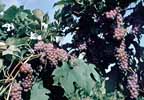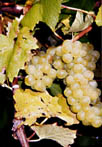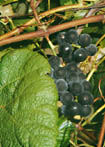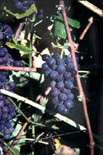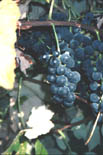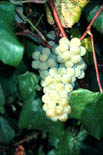Concord
Concord is grown on a greater variety of soils and under a wider range of climatic conditions than any other variety of American grape. Its vine is vigorous and productive, ripening in early to mid-October in New York. The suitability of Concord fruit for multiple purposes gives it a large market potential. It is the most important variety for sweet juice, jelly, and preserves, and it is also used in quantity for wine production and fresh market sales.
Concord produces medium-sized clusters bearing large, blue-black berries. It is typical of the American V. labrusca-derived grapes in having a tough skin which separates readily from the pulpy flesh (slipskin). The pronounced fruity, V. labrusca flavor of Concord makes it a desirable dessert grape. It is the leading table grape variety in New York. However, skin cracking and excessive post harvest shelling, as well as the presence of seeds, limit its use for this purpose. Relative characteristics of Concord and other varieties are listed in Tables 2 and 3. More information on the Concord grape may be found in a separate publication (Zabadal et al., 1988).
Catawba
Catawba is a spicy flavored slipskin grape with a pronounced V. labrusca aroma. It was developed in the very early 1800's. In order to reach full maturity in New York, Catawba requires favorable sites with long growing seasons. The vines are vigorous, hardy and productive, but the foliage is somewhat more susceptible to fungal diseases than that of Concord (Table 2). Catawba also experiences foliar injury where ozone pollution occurs. High acidity may be a problem in some years. Primary usage is for white or pink dessert wines, but it is also used for juice production and marketed fresh as well.
